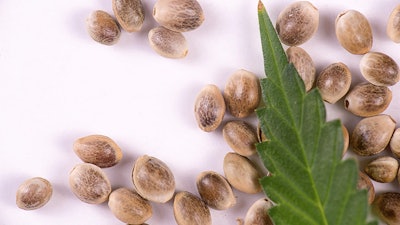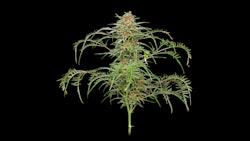
As soon as a new cannabis market launches, one of the first things cultivation companies do after constructing the grow facility is source the cultivars they intend to cultivate and sell. Most of these companies will inevitably strive to source the latest, most popular genetics that have the highest potential retail value due to having desirable qualities like aroma, flavor, color, yield, etc.
However, if every cultivator is chasing after the same genetic qualities, there is a very large possibility that they will ultimately source many of the same chemotypes.
In this market, if a consumer were to visit multiple retailers, they likely would notice that most of them sell the same products that are considered staples to all consumers. But there are two flaws with this logic: First, are the so-called popular products in demand because that’s what consumers are choosing, or are they popular because that is all consumers are being offered? Second, if growers are offering identical products to all retailers, how are they helping those retailers attract repeat customers? If many retailers carry the same products, why would a consumer prefer one dispensary over another?
In the future, I believe companies to some degree may forgo “trends” and stop cultivating genetics based on popularity. Instead, cultivators will try to differentiate themselves by producing signature genetics considered “proprietary” that could even be patentable, protectable, and/or licensable if they are truly unique.
BREED WITH INTENT
Consumer demand will always be a top consideration—it would be pointless to breed cannabis without knowledge of market desires or a specific outcome in mind. Just because one successfully produces cannabis seeds doesn’t mean those seeds are quality, or that the finished product they produce is desirable. There is much more to producing superior desirable genetics than simply breeding two plants. Producers interested in breeding will need to know how to stabilize genetics through hybridization (crossing a superior male specimen (M1) with a superior female one (F1) to produce an F1 hybrid) and backcrossing (producing seeds until the same genetic expression is consistent and stable). That’s not to say it isn’t possible to get lucky, as many have made amazing combinations both on accident and on purpose to produce many popular cultivars. Many “bag seeds” have produced amazing, world-famous cultivars that we remember, know or love today (most famously Chemdog).
Breeding with intent includes doing so ethically. Ethical breeding starts with not stealing or utilizing someone else’s hard-earned intellectual property. When breeding new genetics, always give credit to the original breeder (whenever possible). Cannabis culture speaks loudly, and unsavory (and possibly fraudulent) business practices will be outed eventually. Educated consumers won’t respect misappropriated genetics.
Breeding with intent also means planning your outcome. For example, someone simply taking the two top-selling cultivars and breeding them together likely won’t see satisfactory results. It takes time, multiple generations, hard work and money to properly breed, stabilize and pheno-hunt for superior traits from multiple examples of a given cultivar to hopefully find a plant that exhibits the desired traits that the grower was aiming to enhance. Unstable progeny will never be desirable, as one of the main qualities consumers desire is consistency.
So, how can one breed a signature cultivar without blatantly appropriating genetics from others?
1. Combine landraces with modern genetics.
One option to produce new cultivars is to utilize old-world, landrace genetics. These varieties have been available for a while and are generally considered “public property.”
When breeding landraces and modern genetics, the latter are more likely to pose potential conflicts. Many of the most popular genetics available today, which are the logical genetics to select for breeding, are ethically (although not always legally) the hard-earned intellectual property of their original breeder. This means that simply sourcing landrace genetics and breeding them with multiple popular cultivars available today will garner little respect in the breeding community.
2. Collaborate with other breeders.
Instead of leveraging other people’s work, growers starting their genetic line can collaborate with breeders responsible for the genetics they want to source. In doing so, the original breeders can share in the new variety’s success. After the old-world and modern genetics are bred together and the new variety stabilized, they can yield a genetic library of incredible diversity, which can be then further bred if required to zero-in on the exact desired genetic expressions.
If a breeder is not successful at producing the desired phenotype expressions in four generations, perhaps it’s best to review practices and start the process over.
After the phenotype has been stabilized to the point where it is consistently producing plants with desired traits, growers can select a progeny with which to breed, whether to produce seed, grow as a mother and clone, or tissue culture. If the genotype and phenotype are truly unique, the cultivar might even be patentable.
Sexual Versus Asexual Propagation
Sexual propagation involves the application of male plant pollen to the stigma of a female plant to produce seed. Sexual propagation utilizes seeds to produce new plants.
Asexual propagation involves taking a part of a parent plant and regenerating it into a new plant via cloning, tissue culture or cell culture.
PATENT CONSIDERATIONS
When developing cannabis genetics, breeders may develop proprietary varieties that might be patentable. And, though cannabis patenting is a fairly new world, there is precedent for such events: The first cannabis plant patent was granted in 2014. To date, there are at least 45 cannabis plant patents issued by the U.S. Patent and Trademark Office (USPTO), and The Plant Patent Act of 1930 offers patent protection for new cannabis plant cultivars.
3. Ensure patent applications have all necessary details and descriptions.
A patent application for any plant must include an exact and detailed botanical description, including each characteristic that distinguishes it from all previously existing plants. The patent process requires that the applicant specify how and where the plant was asexually propagated, technical descriptions of the propagation method, as well as scientific descriptions of the methods used to determine the cannabinoid and terpene profiles.
Many cannabis patent applications have been filed and rejected, and some remain pending. The USPTO may reject a patent application for not satisfying the USPTO’s requirements, for example, because the same cultivar was described online. Patent examiners also scrutinize the plant’s name. By law, a U.S. plant patent constitutes registration under the International Union for the Protection of New Varieties of Plants (UPOV), which requires the cultivar to have a name. If another individual or company has a trademark on the proposed cultivar name, the patent examiner can reject the application and advise a name change.
4. Consider each type of patent available for cannabis plants.
There are three protection categories for cannabis or hemp plants that can be granted through the U.S. Patent Office: A utility patent, a plant patent or a USDA plant variety protection (PVP) certificate.
Utility Patents
A utility patent, though rare for the industry, is one of the best options to protect cannabis cultivars because it allows one to claim protection over the plant whether it was asexually or sexually propagated or reproduced. To qualify, the plant must be novel and have a specific, nonobvious use. Utility patents apply for 20 years after the application filing date.
Utility patents are granted to a corporation or person that invents or discovers a new and/or useful machine, process, article of manufacture, or composition of matter. Utility patents give the owner rights that prevent anyone in any patent-protected country from making, using, selling, advertising, or offering to sell or import the claimed invention.
According to a post on the Global IT & Technology Law Blog from the firm Squire Patton Boggs, “It may be possible, in some situations, to get a utility patent that covers cannabis plants as defined by certain features, especially genotypic features. The twelve cannabis plant patents issued to date confirm, however, that it is now possible to patent a distinctive cannabis mother plant —so long as the application is properly prepared.”
Plant Patents
A plant patent can be utilized to protect a cannabis cultivar. The major difference between a utility and a plant patent is that a plant patent can only be obtained for asexually reproduced plants. Plant patents can be granted for any distinct and new cultivar of a plant (other than a plant found in an uncultivated state, like a seed).
There are specific requirements that need to be met to obtain a plant patent, primarily that the specific cannabis plant cultivar needs to be different from all other known related cultivars and have at least one distinguishing characteristic. The distinguishing characteristic must be more than differences caused by variations in environmental conditions, such as lighting source, nutrient application or growing media. Characteristics that qualify as distinctive include elevated levels of given cannabinoids and/or terpene profiles, agronomic characteristics or other unique qualities that no other cultivar possesses.
Plant patents have traditionally been granted for useful sports (genetic mutations) that can be propagated by cloning. For example, a new-colored flower or early flowering fruit tree can be a candidate for a plant patent. A plant patent does not cover plants grown from the patented mother plant’s seeds.
The owner of a plant patent can sell the patented cannabis cultivar, but the purchaser can’t asexually reproduce that plant for their financial gain or profit in any way.
USDA PVP Certificates
USDA PVP certificates are available for hemp varieties only. To qualify for a PVP certificate, the hemp that is desired to be protected must be new, distinct, uniform and stable. PVP certificates have a 20-year term from the issuance date and prohibit others from marketing or selling a protected hemp cultivar.
THE CASE FOR BREEDING
Breeding a proprietary genetic library is expensive and time-consuming (taking anywhere from 12 to 36 months in commercial settings, and sometimes all a breeder’s working years). Yet I still believe it to be a logical path forward for cultivation companies. Rather than chase the flavors of the month and end up competing against the same cultivar from another producer on the store shelf, it will be more advantageous and profitable to breed and cultivate proprietary, patent-protected signature cultivars.
A company that breeds and sources its genetics ethically and intentionally, that innovates and produces desirable cultivars, will prefer to keep them proprietary, patented and protected. This will create opportunities to license the genetics to other companies or to keep them proprietary as a signature product that represents the producer.
I believe it will be imperative to set oneself apart by producing a product that everyone wants, but not everyone has.
Looking for Landrace Genetics? Consider Starting Here. Here are some breeders of landrace genetics and old school staple cultivars, vetted by the author, including Instagram handles:
- @Paklandraceexchange
- @irrazing / fullpowerselections.com
- @landracemafia / Trident seeds
- @landrace_ genetics /kwikseeds.com
- Agseedco.com / Authentic Genetics
Editor’s Note: The companies above were not vetted nor are being endorsed by CBT.

























